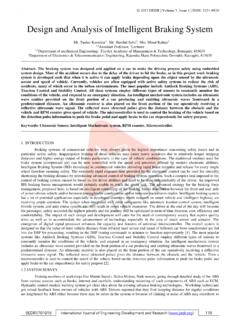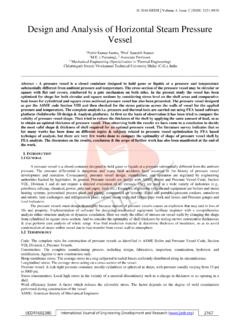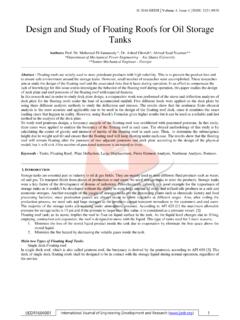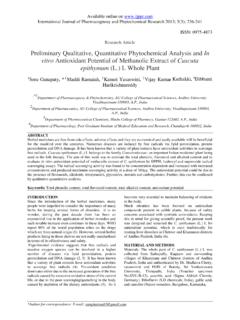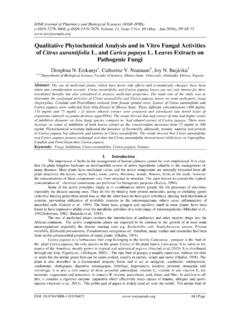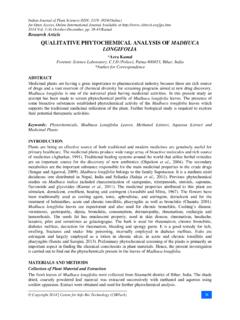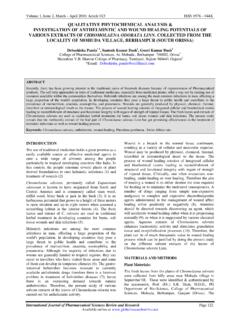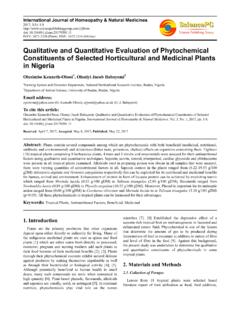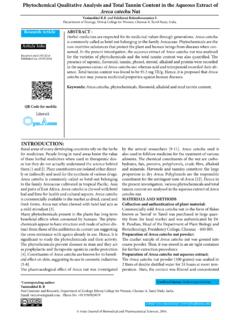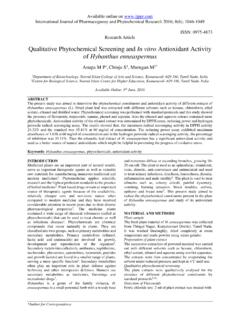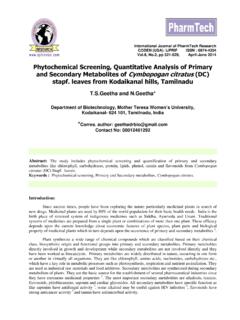Transcription of Qualitative and Quantitative Analysis of Phytochemical ...
1 2016 IJEDR | Volume 4, Issue 2 | ISSN: 2321-9939 IJEDR1602118 International Journal of Engineering Development and Research ( ) 674 Qualitative and Quantitative Analysis of Phytochemical Studies on Brown Seaweed, Dictyota dichotoma 1 Mohammed Deyab, 2 Taha Elkatony and 3 Fatma Ward 1 Professor of microbiology, 2 Professor of plant physiology, 3 Student Botany Department, Faculty of Science, Damietta University, Damietta, Egypt _____ Abstract - In recent years, the secondary metabolites (Phytochemicals) have been extensively investigated as a source of medicinal agents. The sample for the study constitutes Dictyota dichotoma from brown seaweed. It was collected from Hurghada, Red sea coast of Egypt. Four different extracts of Dictyota dichotoma were subjected to Phytochemical Analysis of secondary metabolites both qualitatively and quantitatively by preliminary Phytochemical screening tests of ten different chemical compounds (alkaloids, terpenoids, steroids, tannins, saponins, flavonoids, phenols, coumarins, quinones and glycosides).
2 The result of Phytochemical screening of Dictyota dichotoma showed the presence of alkaloids, terpenoids, steroids, tannins, flavonoids, phenols, coumarins, quinones and glycosides and the absence of saponins. Among the four different extracts, ethyl acetate extract showed the presence of maximum number (9) of compounds. Next to that, Methanol extracts showed seven compounds. Hexane extracts showed six compounds and acetone extracts showed only four compounds. The estimation of total phenolics, tannins and flavonoids were observed in different extracts of Dictyota dichotoma. The Quantitative Phytochemical analyses revealed that secondary metabolites such as phenolics ( mg GAE/g dry wt) and flavonoids ( mg RUE/g dry wt) showed high amounts in methanol extract, while tannins ( mg CAE /g dry wt) showed high amounts in ethyl acetate extract.
3 Index Terms - Seaweed, Secondary metabolites, Dictyota dichotoma, Phytochemical , solvents. _____ I. INTRODUCTION Seaweeds belong to a group of plants known as algae. Seaweeds are classified as Rhodophyta (red algae), Phaeophyta (brown algae) and Chlorophyta (green algae) depending on their nutrient and chemical composition. Seaweeds constitute a vital part of marine ecosystems. It was estimated that about 90% of the species of marine plant are algae and about 50% of the global photosynthesis is contributed from algae [1]. Over the past decades, seaweeds have been used by humans as medicine and food and their extracts have generated an enormous amount of interest in the pharmaceutical industry as a fresh source of bioactive compounds with immense medicinal potential.
4 Seaweeds are the reservoirs of carotenoids, pigments, polyphenols, enzymes, diverse functional polysaccharides. Seaweeds are excellent source of vitamin A, B1, B12, C, D and E [2]. Phytochemicals are responsible for medicinal activity of plants. These are non-nutritive chemicals that have protected human from various diseases [3]. So, Phytochemical Analysis of the seaweeds will be a good preliminary approach to reveal its secondary metabolite constituents and the resultant medicinal values. Seaweeds are a known source of bioactive compounds as they are able to produce a great variety of secondary metabolites characterized by a broad spectrum of biological activities [4]. Seaweeds have generated an enormous amount of interest in the pharmaceutical industry as a fresh source of bioactive compounds with immense medicinal potential [5].
5 Macroalgae produce a wide variety of chemically active metabolites including alkaloids, polyketides, cyclic peptide, polysaccharide, phlorotannins, diterpenoids, sterols, quinones, lipids and glycerols that have a broad range of biological activities [6]. Dictyota is a marine seaweed belonging to Kingdom: Chromista, Subkingdom: Harosa, Infrakingdom: Heterokonta, Phylum: Ochrophyta, Subphylum: Phaeista, Infraphylum: Limnista, Superclass: Fucistia, Class: Phaeophyceae, Order: Dictyotales, Family: Dictyotaceae [7]. Species of Dictyotales (brown algae) produce a large array of bioactive secondary metabolites possessing a broad defensive action against herbivores in the marine environment [8]. Almost a third of the reported brown algal chemistry comes from a single genus, Dictyota, which has elaborated a wealth of terpenes [9].
6 Based on the above facts, the present study aims to screen different solvents of Dictyota dichotoma both quantitatively and qualitatively for the phytochemicals. II. MATERIAL AND METHODS 1. Study area Collection site was along Hurghada shores, Red sea coast of Egypt (Fig. 1); it is one of the most important places of interest for algal growth in Egypt. 2016 IJEDR | Volume 4, Issue 2 | ISSN: 2321-9939 IJEDR1602118 International Journal of Engineering Development and Research ( ) 675 Figure 1: Collection site of Dictyota dichotoma 2. Collection and preparation of Dictyota dichotoma The selected sample of Dictyota dichotoma is a known species of brown seaweed (Fig. 2). It was collected by hand, washed with seawater at the sampling site to remove the adhered sediments and impurities and then packed in polyethylene bags and brought to the laboratory for further analyses.
7 Then it was washed successively with tap water, distilled water to remove all the salt on the surface. The water was drained off and the seaweed was spread on blotting paper to remove excess water. The clean seaweed was shade dried and then kept in an oven 60 C for 4hrs. The dried algal material was ground to 2 mm or smaller particle size. Figure 2: Selected sample of Dictyota dichotoma. 3. Preparation of algal extracts The seaweed powder was successively extracted using solvents of increasing polarity according to Arokiyaraj et al (2009) [10] with some modifications. 15 g powder was initially soaked in 60 ml of hexane in air tight conical flask for two days. The flask was periodically subjected to shaking on an electronic shaker and then it was first filtered through double layered muslin cloth and then filtered through Whatman no 1 filter paper and filtrate was collected into sterile air tight bottle.
8 Likewise, the above methods were repeated using ethyl acetate, acetone and methanol. 4. Qualitative Analysis of Phytochemical substances in algal extracts The Phytochemical screening of different algal extracts was assessed by standard method as described by Savithramma et. al. (2011) [11]. Phytochemical screening was carried out to identify the major natural chemical groups such as alkaloids, terpenoids, 2016 IJEDR | Volume 4, Issue 2 | ISSN: 2321-9939 IJEDR1602118 International Journal of Engineering Development and Research ( ) 676 steroids, tannins, saponins, flavonoids, phenols, coumarins, quinones and glycosides. General reactions in these analyses revealed the presence or absence of these compounds in the algal extracts tested. Phytochemical Analysis 1. Test for Alkaloids For Alkaloid identification, 2 mL of concentrated Hydrochloric acid (HCl) was added to 2 mL algal extract.
9 Then few drops Mayer s reagent was added. Presence of green color or white precipitate indicates the presence of alkaloids. 2. Test for Terpenoids For Terpenoids identification, 2 mL of chloroform along with concentrated Sulphuric acid were added to ml of the algal extract. Formation of reddish brown color at the interface indicates the presence of Terpenoids 3. Test for Steroids For steroids identification, 2 mL of chloroform and 1 mL of sulphuric acid (H2SO4) were added to mL of the algal extract. Formation of reddish brown ring at interface indicates the presence of steroids. 4. Test for Tannins For tannins identification, one mL of ferric chloride (5% FeCl3) was added to 1 mL of the algal extract. Formation of dark blue or greenish black color indicates the presence of tannins. 5. Test for Saponins For saponins identification, 2 mL of distilled water was added to 2 mL algal extract and shaken in graduated cylinder for 15 min lengthwise.
10 Formation of 1 cm layer of foam indicates the presence of saponins. 6. Test for Flavonoids For flavonoids identification, 1 mL of 2N sodium hydroxide (NaOH) was added to 2 mL of algal extract. Formation of yellow color indicates the presence of flavonoids. 7. Test for Phenols For phenols identification, 2 mL of distilled water followed by few drops of 10 % ferric chloride was added to 1 mL of the algal extract. Formation of blue / green color indicates the presence of phenols 8. Test for Coumarins For coumarins identification, 1 mL of 10 % NaOH was added to 1 mL of algal extract. Formation of yellow color indicates the presence of coumarins. 9. Test for Quinones For Quinone identification, 1 mL of concentrated sulphuric acid (H2SO4) was added to 1 mL algal extract. Formation of red color indicates the presence of quinones.

